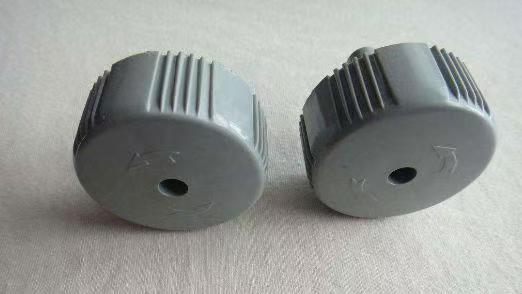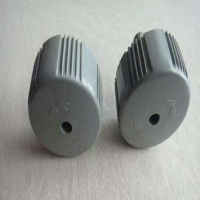Nguyên nhân và giải pháp của vết lõm trên các sản phẩm đúc phun, hoàn thành không đầy đủ và flash trên các sản phẩm
Nguyên nhân và giải pháp của vết lõm trên các sản phẩm đúc phun, hoàn thành không đầy đủ và flash trên các sản phẩm
Khuôn đúc hàng hóa Công ty TNHH khuôn đúc jiefeng (jfmoulds.com)
| Khiếm khuyết sản phẩm | Lý do có thể | Giải pháp |
| Thụt sản phẩm | (1) Hợp chất cao su không đủ trong khoang khuôn gây co lại 1. Đổ đầy đủ hoặc số tiền cho ăn không đủ 2. Vị trí cổng chính hoặc không đối xứng của cổng 3. Người chạy hoặc cổng không đủ hoặc quá nhỏ 4. Độ dày thành của sản phẩm không đồng đều và các vết lõm dễ xảy ra ở mặt sau tại các khu vực có thành dày | Thực hiện điều chỉnh và sửa chữa 1. Nổi vào việc cho ăn hoặc mở cổng cổng phóng điện rộng hơn 2 3. Tăng số lượng kênh chạy và phóng to kích thước cổng 4. Cái chết làm việc có thể được sửa đổi hoặc áp lực tiêm có thể được tăng lên |
(2) Điều chỉnh không đúng các thông số công nghệ quy trình 1. Áp lực tiêm thấp và tốc độ tiêm chậm 2. Cài đặt thời gian tiêm quá ngắn 3. Cài đặt thời gian giữ áp lực quá ngắn 4. Cài đặt thời gian làm mát quá ngắn | Thực hiện điều chỉnh và sửa chữa 1. Động tác và tăng áp lực tiêm và tốc độ tiêm 2. Tăng giá trị cài đặt của thời gian tiêm 3. Tăng giá trị cài đặt thời gian giữ áp lực 4. Tăng giá trị cài đặt thời gian làm mát | |
(3) nhựa quá nóng 1.The plastic is overheating and the temperature setting of the melt cylinder is too high 2.The mold temperature is too high. 3.There is local overheating in the mold or overheating when the product is demolded | Thực hiện điều chỉnh và sửa chữa 1.Reduce the temperature setting value of the melt glue cylinder 2.Reduce the mold temperature and adjust t3.he inlet gate valve of the cooling system | |
| (4) The material temperature is too low or the plasticization is poor, resulting in poor flow of the molten material | Increase the temperature of the heating zones in each section of the melt glue cylinder to test the degree of plasticization of the rubber compound | |
| The finished product is not satisfactory | 1.The material "Bridges" in the hopper, resulting in insufficient feeding. 2.Insufficient injection volume, inadequate plasticizing capacity and insufficient leftover material. 3.The diversion channel is insufficient or the gate is small. 4.The flow state of the molten adhesive flowing into the multi-cavity die cannot be properly balanced. 5.The amount of molten glue in the mold cavity is greater than the injection volume of the injection molding machine. 6.The flow resistance of the mold gating system is large, the position of the feed port is improper, the cross-section is small and the form is poor, the flow process is long and tortuous. 7.Air cannot be expelled from the mold cavity. 8.The plastic contains a lot of moisture, volatile substances or has a large amount of gas in 9.the molten material. 9.The nozzle temperature is low, the barrel temperature is low, causing blockage, or the nozzle hole diameter is too small. 10.The injection pressure is low and the injection speed is slow. 11.The injection time setting is too short. 12.The pressure-holding time setting is too short. 13.The fluidity of the plastic is too poor, resulting in excessive flash and overflow. 14.The mold temperature is too low and the plastic cools down too quickly. 15.Excessive use of demolding agent, moisture in the mold cavity, etc. 16.The wall of the product is too thin, the shape is complex and the area is large. | 1. Inspect the water transport ring cooling system to eliminate the "bridging" phenomenon 2.Reduce the injection volume to maintain a fixed material intake and enhance the plasticizing capacity 3. Add more runner channels or increase the gate size 4. Correct the situation of unbalanced flow state 5. Use a larger injection molding machine or reduce the number of model cavities in the working mold 6. Improve or modify the mold gating system, including aspects such as the position, cross-section, form and flow of the feed inlet 7. Increase the number or size of exhaust ducts 8.Before plastic injection molding, it should be dried to ensure the mixing ratio and reduce impurities 9. Increase the temperature of the barrel and the nozzle to ensure adequate plasticization, and replace the nozzle with a larger aperture 10. Increase the values of injection pressure and speed parameters 11. Increase the setting value of the injection time parameter 12. Increase the setting value of the pressure-holding time parameter 13. Correct the parameter values of the temperature setting to prevent material overflow 14. Adjust the mold temperature and cooling time 15. Reasonably control the dosage of mold release agent to prevent excessive moisture 16. Try your best to reduce the complexity of the products |
| Product flash | 1.The projected area of the product exceeds the maximum product area allowed by the injection machine 2.The mold is installed incorrectly or subjected to unidirectional force 3.The injection molding machine template is not parallel or the tie rods are unevenly deformed 4.Poor parallelism of the mold or obstruction at the mold edge 5.The parting surface of the mold does not fit well, and the clearance between the cavity and the core or the sliding parts is too large. 6.The plastic has too much fluidity and the feeding amount is too large 7.The cavity material temperature is high, and the mold temperature is too high 8.The injection pressure is too high and the injection speed is too fast 9.The clamping force is not constant or uneven | 1.Choose a larger injection molding machine or select products of an appropriate area Mold 2. Check the installation of the mold and secure and press it tightly 3. Check whether the template and the tie rods are parallel and make corrections to eliminate deformation 4. Clean or grind the mold edges and check the parallelism of the mold 5. Check whether the parting surface of the mold is clean and free of debris, correct the offset or clearance, or replace the parts 6.The feeding amount is properly controlled 7. Control the temperature of the heating melt glue cylinder and the mold temperature 8. Reduce the setting of injection pressure and speed parameter values 9. Adjust the clamping force parameters or correct the symmetry on both sides of the die |

Thông tin liên quan
Nguyên nhân và giải pháp của vết lõm trên các sản phẩm đúc phun, hoàn thành không đầy đủ và flash trên các sản phẩm
2025-07-29
Nguyên nhân và giải pháp của vết lõm trên các sản phẩm đúc phun, Finis không hoàn chỉnh ...
"Bậc Thầy tạo hình" ẩn giấu trong những nhu yếu phẩm hàng ngày
2025-07-17
"Bậc Thầy tạo hình" ẩn giấu trong các nhu yếu phẩm hàng ngày trong sản phẩm công nghiệp ngày nay...
Cấu trúc, vật liệu và thiết kế khuôn phun
2025-07-18
Cấu trúc, vật liệu và thiết kế khuôn phun trong cảnh quan rộng lớn...
Xác định khung mẫu mới cho ngành công nghiệp khuôn phun thông qua các đột phá công nghệ và tái tạo sinh thái
2025-07-04
Định nghĩa một mô hình mới cho ngành công nghiệp khuôn phun thông qua công nghệ BREA...
Khuôn phun: Nền tảng chính xác và động cơ đổi mới của sản xuất công nghiệp
2025-07-02
Khuôn phun: Nền tảng chính xác và động cơ đổi mới của công nghiệp ma...
Chìa khóa cho việc đúc sản phẩm nhựa
2025-07-21
Chìa khóa cho sản phẩm nhựa đúc trên thế giới dẻo của Produ ngày nay ...





